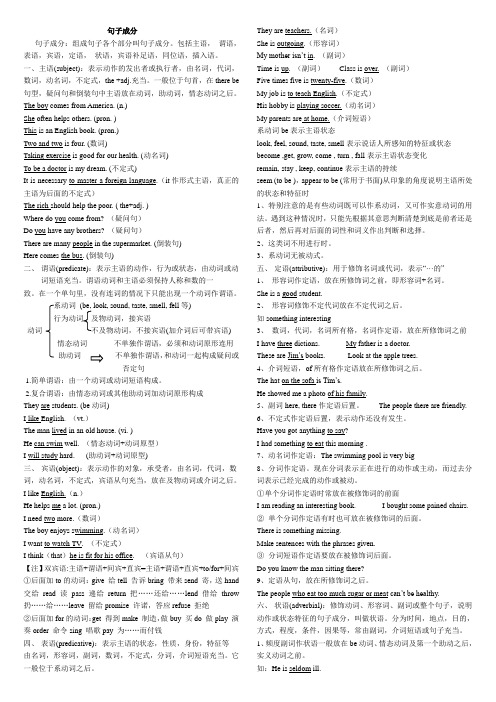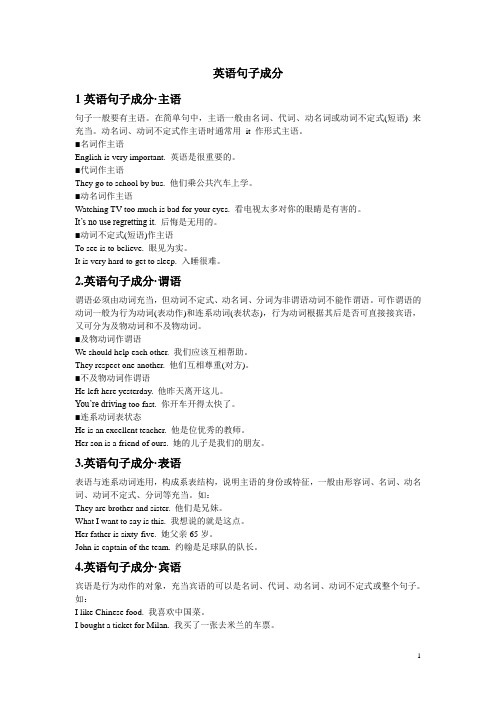英语句子成分分析
英语句子成分分析必备(超实用)

句子成分分析一、主语主语是放在句子中说明全句中心主题的部分。
一般由名词、代词、不定式、动名词或从句充当。
【一般放在句首】1、English is very important.(英语是很重要的)2、A tree has fallen across the road.(一棵树倒下横在马路上)3、Little streams feed big rivers (小河流入大江)1、You’re not far wrong.(你差不多对了)2、He told a joke but it fell flat. (他说了个笑话,但没有引人发笑)3、They go to school by bus.(他们乘公共汽车去上学)4、Most of the students come from the countryside.(大多数的学生来自农村)1、Watching TV too much is bad for your eyes. (看太多的电视对你的眼睛有害的)2、It’s no use regretting it.(后悔是没有用的)3、Smoking is bad for you. (吸烟对你有害)4、To see is to believe.(眼见为实/百闻不如一见)5、It is very hard to get to sleep.(入睡很难。
)6、To find your way can be a problem.(你能否找到路可能是一个问题。
)7、It would be nice to see him again. (如能见到他,那将是一件愉快的事。
)1、Three is enough. (三个就够了)2、Four from seven leaves three.(7减4还剩3)1、Whenever you are ready will be fine. (你无论什么时候准备好都行。
)2、Because Sally wants to leaves doesn’t mean that we have to.(不能说萨利要走因而我们也得走。
英语句子成分分析

句子成分句子成分:组成句子各个部分叫句子成分。
包括主语,谓语,表语,宾语,定语,状语,宾语补足语,同位语,插入语。
一、主语(subject):表示动作的发出者或执行者,由名词,代词,数词,动名词,不定式,the +adj.充当。
一般位于句首,在there be句型,疑问句和倒装句中主语放在动词,助动词,情态动词之后。
The boy comes from America. (n.)She often helps others. (pron. )This is an English book. (pron.)Two and two is four. (数词)Taking exercise is good for our health. (动名词)To be a doctor is my dream. (不定式)It is necessary to master a foreign language.(it作形式主语,真正的主语为后面的不定式)The rich should help the poor. ( the+adj. )Where do you come from? (疑问句)Do you have any brothers? (疑问句)There are many people in the supermarket. (倒装句)Here comes the bus. (倒装句)二、谓语(predicate):表示主语的动作,行为或状态,由动词或动词短语充当。
谓语动词和主语必须保持人称和数的一致。
在一个单句里,没有连词的情况下只能出现一个动词作谓语。
系动词(be, look, sound, taste, smell, fell等)行为动词及物动词,接宾语动词不及物动词,不接宾语(加介词后可带宾语)情态动词不单独作谓语,必须和动词原形连用助动词不单独作谓语,和动词一起构成疑问或否定句1.简单谓语:由一个动词或动词短语构成。
英语句子成分分析

英语句子成分分析英语句子成分分析是语法研究的重要内容之一。
它主要通过对英语句子的结构和语义进行分析,来揭示句子中各个成分之间的关系和作用。
下面我将为您详细阐述英语句子成分分析的相关知识。
一、名词短语(Noun Phrase)名词短语是由名词充当中心词,再加上其他修饰词来构成的短语。
名词短语可以作为句子的主语、宾语、补语等。
1. 主语(Subject)主语通常是句子的中心成分,它指出动作的执行者或者是表达状态的主体。
例句:The cat is sleeping.翻译:猫正在睡觉。
2. 宾语(Object)宾语是句子中受到动作影响的对象,它常跟在动词之后。
例句:I like apples.翻译:我喜欢苹果。
3. 补语(Complement)补语是用来补充说明主语或宾语的信息,起到对主谓关系进行补充和修饰的作用。
例句:She is a teacher.翻译:她是一位老师。
二、动词短语(Verb Phrase)动词短语是以动词为核心,并包含了与之相关的其他成分,如副词、介词短语等。
1. 谓语动词(Predicate Verb)谓语动词是句子中的核心成分,它直接说明主语的动作或状态。
例句:He is running.翻译:他正在跑步。
2. 直接宾语(Direct Object)直接宾语是跟在及物动词后面,指出受到动作影响的对象。
例句:She loves flowers.翻译:她喜欢花。
3. 间接宾语(Indirect Object)间接宾语是在及物动词之后,介词之前,用来指示动作的对象。
例句:He gave me a book.翻译:他给了我一本书。
三、形容词短语(Adjective Phrase)形容词短语是由形容词作为中心词,并可以加上其他修饰词来修饰名词或代词。
例句:The tall girl is my sister.翻译:那个高个子的女孩是我的姐姐。
四、副词短语(Adverb Phrase)副词短语是由副词作为中心词,并可以有其他修饰词来修饰动词、形容词或副词。
英语句子成分分析法结构解析

英语句子成分分析法结构解析很多同学对英语的句子成分搞不懂,所以就影响了他们的阅读和写作,以及做其他类型题目的能力。
今天店铺为大家带来了英语句子成分分析,欢迎大家阅读!英语句子成分分析篇一一、句子成分(一)句子成分的定义:构成句子的各个部分叫做句子成分。
句子成分有主要成分和次要成分;主要成分有主语和谓语;次要成分有表语、宾语、定语、状语、补足语和同位语。
(二)主语:主语是一个句子所叙述的主体,一般位于句首。
但在there be结构、疑问句(当主语不疑问词时)和倒装句中,主语位于谓语、助动词或情态动词后面。
主语可由名词、代词、数词、不定式、动名词、名词化的形容词和主语从句等表示。
例:划出下列句子的主语,并在括号内写出它的词性或充当的是什么从句。
1. During the 1990s, American country music has become more and more popular.( )2. We often speak English in class.( )3. One-third of the students in this class are girls.( )4. To swim in the river is a great pleasure.( )5. Smoking does harm to the health.( )6. The rich should help the poor.( )7. When we are going to have an English test has not been decided.( )8. It is necessary to master a foreign language.( )(三)谓语:谓语说明主语所做的动作或具有的特征和状态。
动词在句中作谓语,一般放在主语之后。
谓语的构成如下:1、简单谓语:由一个动词或动词短语构成。
英语句子成分分析

英语句子成分分析英语句子由多个成分构成,这些成分包括主语、谓语、宾语、表语、定语、状语和补语等。
以下是对这些成分的详细解析:1. 主语(Subject):句子的核心,表示动作的执行者或者是名词的所在者。
例如:- The cat is sleeping.(主语:The cat)2. 谓语(Predicate):用来说明主语的动作、状态、特征或者存在。
例如:- She is running.(谓语:is running)3. 宾语(Object):动作的承受者或接受者,它可以是直接宾语或间接宾语。
例如:- The man bought a book.(直接宾语:a book)- She gave her sister a gift.(间接宾语:her sister)4. 表语(Predicate Nominative):用来说明主语的身份、特性、状态等。
例如:- He is a doctor.(表语:a doctor)5. 定语(Adjective):对名词或代词进行修饰或限定。
例如:- The red car is mine.(定语:red)6. 状语(Adverbial):修饰动词、形容词、副词或整个句子,用来表示时间、地点、方式、原因、程度等信息。
例如:- He runs fast.(状语:fast)- They went to the park yesterday.(状语:yesterday)例如:- She became a teacher.(补语:a teacher)这些成分在句子中起着不同的作用,使句子更加完整和表达更加准确。
英语句子成分分析说明

英语句子成分分析说明英语句子由不同的成分组成,每个成分在句子中承担不同的语法功能。
以下是常见的英语句子成分及其功能的说明:1. 主语(Subject):句子中执行动作的人或事物,通常是名词、代词或名词性短语。
例如,在句子 "She is studying." 中, "She" 是主语。
2. 谓语(Predicate):句子中描述主语动作或状态的部分,通常是动词或动词短语。
例如,在句子 "She is studying." 中, "is studying" 是谓语。
3. 宾语(Object):句子中受到动作影响的人或事物,通常是名词、代词或名词性短语。
例如,在句子 "She is studying English." 中,"English" 是宾语。
5. 定语(Adjective):句子中用来修饰名词或代词的词或短语,通常是形容词或形容词短语。
例如,在句子 "The red car is fast." 中,"red" 是定语。
6. 状语(Adverb):句子中用来修饰动词、形容词、副词或句子的成分,通常是副词或副词短语。
例如,在句子 "He runs quickly." 中,"quickly" 是状语。
7. 同位语(Appositive):句子中用来解释或说明名词或代词的成分,通常是同位语从句、名词短语或动名词短语。
例如,在句子 "My uncle, a doctor, visited us." 中, "a doctor" 就是同位语。
8. 表语(Predicative):句子中用来说明主语的状态、性质或身份的成分,通常是形容词、名词或名词性短语。
例如,在句子 "She is tall." 中, "tall" 是表语。
英语句子成分分析大全

英语句子成分分析大全
一.主语subject:是一句话的中心,整句话都谈它的情况。
二.谓语predicate:是对主语加以陈述,表示主语的行为或者状态。
谓语必须由动词或动词短语充当,因此动词不定式、动名词、分词为非谓语动词,不能作谓语。
且谓语动词可以体现时态,单复数的语法现象。
三.宾语object:表示动作的承受者。
宾语放在及物动词transitive verb或者介词preposition之后。
四.表语predicative:用来说明主语的性质或状态。
接在系动词link verb之后,其中接在系动词be 后是最常见的情况。
五.定语attribute:是用来说明或限制名词的成分,可分为前置定语和后置定语,常用形容词或者相当于形容词的短语或从句担任。
形容词放在名词之前,构成前置定语;相当于形容词的短语或从句放在名词的后面,构成后置定语。
六.状语adverbial:是用来修饰动词,形容词,副词或整个句子的成分。
常由副词担任。
修饰动词时可以放在动词之前,也可以放在动词之后;修饰形容词或副词时放在它们之前。
区别状语与定语的关键就是看其所修饰的部分,定语修饰名词,且起说明、限制作用。
七.同位语appositive:一个名词(或其它形式)对另一个名词或代词进行修饰,限定或说明,这个名词(或其它形式)就是同位语。
同位语与被它限定的词常常紧挨在一起。
八.补语complement:起补充说明的作用。
去掉补语部分,整个句子的意思就不完整了,这就是补语与定语状语的关键区别。
英语句子成分分析

英语句子成分1英语句子成分·主语句子一般要有主语。
在简单句中,主语一般由名词、代词、动名词或动词不定式(短语) 来充当。
动名词、动词不定式作主语时通常用it 作形式主语。
■名词作主语English is very important. 英语是很重要的。
■代词作主语They go to school by bus. 他们乘公共汽车上学。
■动名词作主语Watching TV too much is bad for your eyes. 看电视太多对你的眼睛是有害的。
It’s no use regretting it. 后悔是无用的。
■动词不定式(短语)作主语To see is to believe. 眼见为实。
It is very hard to get to sleep. 入睡很难。
2.英语句子成分·谓语谓语必须由动词充当,但动词不定式、动名词、分词为非谓语动词不能作谓语。
可作谓语的动词一般为行为动词(表动作)和连系动词(表状态),行为动词根据其后是否可直接接宾语,又可分为及物动词和不及物动词。
■及物动词作谓语We should help each other. 我们应该互相帮助。
They respect one another. 他们互相尊重(对方)。
■不及物动词作谓语He left here yesterday. 他昨天离开这儿。
Y ou’re drivi ng too fast. 你开车开得太快了。
■连系动词表状态He is an excellent teacher. 他是位优秀的教师。
Her son is a friend of ours. 她的儿子是我们的朋友。
3.英语句子成分·表语表语与连系动词连用,构成系表结构,说明主语的身份或特征,一般由形容词、名词、动名词、动词不定式、分词等充当。
如:They are brother and sister. 他们是兄妹。
- 1、下载文档前请自行甄别文档内容的完整性,平台不提供额外的编辑、内容补充、找答案等附加服务。
- 2、"仅部分预览"的文档,不可在线预览部分如存在完整性等问题,可反馈申请退款(可完整预览的文档不适用该条件!)。
- 3、如文档侵犯您的权益,请联系客服反馈,我们会尽快为您处理(人工客服工作时间:9:00-18:30)。
句子成分(Sentence Members)句子成分和结构是英语的基础,是理解和表达英语的关键。
英语中许多词类都对句子成分和结构有影响。
英语中的句子是由词或短语组成的,这些词或短语在句子中起一定的作用,叫做句子成分。
英语的篇章是由句子构成的,不同的内容需要不同类型的句式结构,这些句式结构又构成英语中不同的句子类型。
学习英语句法的基础是了解句子成分、句子的基本结构和句子种类。
在英文中句子成分包括:主语、谓语、宾语(直接宾语、间接宾语)、表语、定语和状语、宾语补足语等。
(一)主语:主语是谓语讲述的对象,表示所说的“是什么”或“是谁”。
一般由名词、代词、不定式或相当于名词的词或短语来充当。
它在句首。
如:(1)Lucy is a beautiful nurse. (名词作主语)(2)He reads newspapers every day. (代词作主语)(3)Smoking is harmful to the health. (动名词作主语)(4)To swim in Kunming Lake is a great pleasure.(不定式作主语)(5)What we should do is not yet decided. (主语从句作主语)练一练:指出下例句中主语的中心词。
1).The teacher with two of his students is walking into the classroom.2).There is an old man coming here.3).The useful dictionary was given by my mother last year.4).To do today's homework without the teacher's help is very difficult.(二)谓语说明主语“做什么”“是什么”或“怎么样”。
谓语谓语和主语在人称和数两方面必须一致。
它在主语后面。
如:His parents are teachers. (系动词和表语一起作谓语)We study hard. (行为动词作谓语)We don’t finish reading the book. (助动词和行为动词一起作谓语)He can speak English. (情态动词和行为动词一起作谓语)练一练:选出句中谓语的中心词。
① I don't like the picture on the wall.② The days get longer and longer when summer comes.③ Do you usually go to school by bus?④ There will be a meeting at the library this afternoon.⑤ Did the twins have porridge for their breakfast?⑥ Tom didn't do his homework yesterday.⑦ What I want to tell you is this.⑧ We had better send for a doctor.三)宾语宾语是动作、行为的对象,由名词、代词、不定式或相当于名词的词、短语来担任,它和及物动词一起说明主语做什么。
一般放在谓语之后。
She is doing her homework now.(名词作宾语)She says(that)she is ill.(宾语从句作动词宾语)We often help him.(代词作宾语)He likes to play basketball.(不定式作宾语)We enjoy listening to the music. 我们喜欢听音乐。
(动名词短语作宾语)练一练:挑出下列句中的宾语。
① My brother hasn't done his homework.② People all over the world speak English.③ You must pay good attention to your pronunciation.④ How many new words did you learn last class?⑤ Some of the students in the school want to go swimming, how about you?说明1:宾语是及物动词涉及到的人或物,宾语一般放在及物动词之后。
介词后面的名词或代词或动名词,称为介词宾语。
名词、代词、数词常在句中做动词宾语或介词宾语。
另外,动词不定式可作动词宾语;动名词和宾语从句也可用作动词宾语。
说明2:及物动词作谓语时,后面要跟宾语。
宾语分直接宾语和间接宾语。
直接宾语,间接宾语通常是及物动词的动作所及的人,间。
间接宾语一般放在直接宾语之前。
不是所有的及物动词都可以用双宾语。
有的动词可以跟。
如:give, showbring, pass, buy 等。
如:(1)Our teacher tells us a story.(2)The sun gives us light.“人”间接宾语前加“to”的有:give, show, send, bring, read, pass, lend, leave, hand, tell, return, write, throw, promise(答应), refuse(拒绝)等。
间接宾语加“for”的有:make, buy, do, get, play, order(命令), sing, pay等(1)I give him a book. 改成:(2)He passes me the book.(他将书递给我。
)改成:(3)He writes me a letter. 改成:(4)He will buy me some books. 改成:(5)She is making me a cake. 改成:练一练:划出句中的直接宾语和间接宾语。
①Please tell us a story.② My father bought a new bike for me last week.③ Mr Li is going to teach us history next term.④ Here is a pen.Give it to Tom.⑤ Did he leave any message for me?(四)宾语补足语在宾语后面补充说明宾语的动作、状态、特征的成分,称为宾语补足语。
名词、形容词、副词、介词短语以及动词不定式、分词等可用作宾语补足语。
宾语和宾语补足语称为复合宾语。
如:They make her happy.(形容词)I see her dance.(不定式)We’ll help you to make the Olympics a success.(名词)Please let him in.(副词)We heard her singing a song.(分词短语)(五)表语表语说明主语“是什么”或者“怎么样”,由名词、形容词、副词、介词、不定式及相当于名词或形容词或短语来担任。
它的位置在系动词后面。
如:I am a teacher.(名词)He is always happy.(形容词)They are on the playground now.(介词短语)It gets cold.(形容词)系动词Be动词(am,is,are, was, were)表保持(keep, stay, remain)表改变(get,become,turn)感官动词(feel,sound(听起来),seem/look(看起来),taste,smell 如:It sounds interesting.(sound为系动词,interesting为表语)We should all remain careful. Remain(为系动词,careful为表语)练一练:挑出下列句中的表语。
①The old man was feeling very tired.② Why is he worried about Jim?③ The leaves have turned yellow.④ Soon They all became interested in the subject.⑤ She was the first to learn about it.(六)定语定语是用来修饰名词或代词的。
形容词、代词、数词、名词、介词短语、不等式或相当于形容词的词或短语等。
单个词作定语时,通常放在它所修饰的名词之前。
如:The black bike is mine.(形容词)What’s your name?(代词)They make paper flowers.(名词)练一练:挑出下列句中的定语。
① They use Mr, Mrs with the family name.② What is your given name?③ On the third lap are Class 1 and Class 3.④ I am afraid some people forgot to sweep the floor.⑤ The man downstairs was trying to sleep.⑥ I am waiting for the sound of the other shoe!说明1:nothing, anything, everything, something等时,定语在不定代词后面。
如:I tell him something interesting. (形容词interesting作不定代词something的后置定语)(to do为不定式作后置定语)说明2作定语时,也放在被修饰的名词之后。
如:The boys in the room are in Class Four. (in the room是介词短语作the boys 的后置定语。
)(七)状语修饰动词、形容词、副词。
一般表示行为发生的时间、地点、目的、方式、程度等意义,一般由副词、介词短语、不定式或相当于副词的词或短语来表示。
状语一般放在句末,但有的可以放在句首、句中。
如:He did it carefully.(副词)Her mother goes out to do some shopping on Sunday.(介词短语)When I grow up, I am going to be a teacher.(从句作时间状语)He sits there.(副词地点状语)练一练:挑出下列句中的状语。
